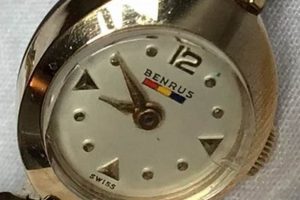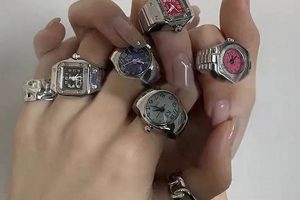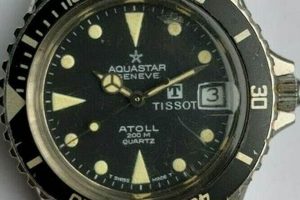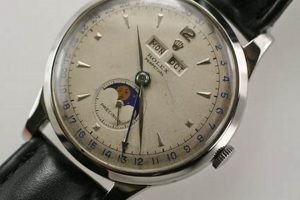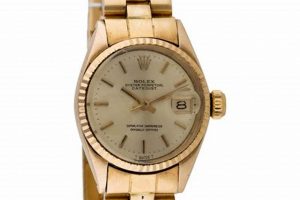A timepiece, often dating back several decades, that integrates a metal band as an integral part of its overall design, creating a unified aesthetic. These items often showcase design characteristics and manufacturing techniques prevalent in their respective eras, offering a glimpse into horological and jewelry trends of the past. For example, a model from the 1950s might feature intricate meshwork or bold geometric patterns on its band, reflecting the design sensibilities of that period.
These items hold significance for collectors, enthusiasts, and individuals seeking unique accessories. They represent tangible links to historical periods, embodying the craftsmanship and artistry of bygone eras. The value often stems from factors such as rarity, condition, brand reputation, and historical importance. Beyond their monetary worth, they offer a distinct aesthetic appeal and a way to express individual style through a connection to the past.
The following discussion will delve into the key aspects of identifying, evaluating, and maintaining these unique adornments, ensuring their preservation and continued appreciation for generations to come. The nuances of movement types, case materials, and restoration techniques will be examined.
Essential Considerations
The acquisition and preservation of horological items with integrated metal bands requires careful attention to detail. The following guidelines are designed to aid in informed decision-making and responsible ownership.
Tip 1: Research the Brand and Model: Prior to any purchase, comprehensive research into the specific manufacturer and model is paramount. Understanding the history, production numbers, and known issues associated with a particular model can significantly impact its perceived value and long-term maintenance requirements. Consult horological archives, specialized forums, and reputable dealers for accurate information.
Tip 2: Assess Condition Meticulously: Thoroughly examine the item’s condition, paying close attention to the band’s integrity, the case’s surface, and the functionality of the movement. Evidence of excessive wear, corrosion, or amateur repairs can detract significantly from value and potentially compromise its operational capabilities. Utilize a loupe for detailed inspection of intricate components.
Tip 3: Verify Authenticity: The market is rife with counterfeit and frankenwatches. Scrutinize the item’s hallmarks, movement serial numbers, and design features to ensure conformity with known specifications. Comparison with documented examples and expert authentication are crucial steps to mitigate the risk of acquiring a non-genuine item.
Tip 4: Inquire About Service History: A comprehensive service record is indicative of responsible ownership and proactive maintenance. Obtain documentation detailing previous repairs, part replacements, and overall servicing intervals. Absence of a service history may suggest potential underlying mechanical issues.
Tip 5: Understand Replacement Part Availability: The ability to source replacement components is a critical factor in long-term ownership. Research the availability of original or compatible parts before committing to a purchase. Scarce or non-existent parts can render an otherwise desirable model impractical for regular use or restoration.
Tip 6: Account for Restoration Costs: Budget accordingly for potential restoration expenses. Refinishing a tarnished case or repairing a damaged band can be costly endeavors. Obtain estimates from qualified horologists before committing to any extensive restoration work. Consider the potential impact on the item’s originality and historical value.
Tip 7: Proper Storage and Handling: Preserve the integrity of the item by storing it in a dry, dust-free environment, away from direct sunlight and extreme temperature fluctuations. Handle the item with care, avoiding harsh chemicals, abrasive materials, and magnetic fields. Regular cleaning with a soft cloth will help maintain its luster.
Adherence to these recommendations will enable the informed acquisition and conscientious stewardship of these historical timepieces, ensuring their continued value and aesthetic appeal.
The subsequent sections will explore the practical aspects of cleaning, insuring, and valuing these elegant accessories.
1. Authenticity Verification
The process of establishing genuineness is paramount when dealing with timekeeping devices featuring integrated metal bands that are of advanced age. These artifacts, owing to their age and inherent value, are frequently the subject of forgery or misrepresentation. Therefore, rigorous verification is not merely a desirable precaution, but a fundamental prerequisite for responsible acquisition and preservation. The implications of failing to ascertain the genuine nature of the item can range from financial loss to the perpetuation of historical inaccuracies.
Consider, for instance, the case of a purportedly rare example from a renowned Swiss manufacturer. Superficial examination might reveal a seemingly intact exterior, complete with the correct engravings and markings. However, closer scrutiny by a trained horologist could uncover a movement that is not consistent with the stated production period, or a bracelet that has been replaced with a non-original component. Such discrepancies, if overlooked, could lead to a significant overvaluation and subsequent financial detriment. Moreover, the existence of convincing replicas necessitates expertise in identifying subtle variations in dial printing, case finishing, and movement construction.
In conclusion, Authentication is more than just verifying a brand name. It is a comprehensive process requiring expertise, meticulous examination, and access to reliable historical records. This diligent approach safeguards against deception, preserves the integrity of the historical record, and ensures that the timekeeping item with integrated band is appreciated for its true heritage and value. Failure to prioritize verification can have significant consequences, undermining both the financial and historical significance of the timekeeping object.
2. Band Material
The constituent materials of the band are integral to the overall value, durability, and aesthetic character of horological devices with integrated metal bands originating from past eras. The selection of materials directly influenced not only the physical longevity of the item but also its perceived status and stylistic relevance during its period of production. For example, high-end models frequently employed solid gold or platinum, signifying luxury and exclusivity, while more accessible models utilized stainless steel or gold-plated alloys for increased affordability. The choice of material also dictated the band’s susceptibility to corrosion, scratching, and general wear, impacting its preservation over time. The presence of original band materials, in good condition, often enhances an items collectibility and historical accuracy.
Consider the practical implications: a stainless-steel bracelet, common in mid-century sports models, offered robust durability and resistance to the elements, aligning with the active lifestyles of the period. Conversely, intricately designed gold bracelets, often found in dress models, conveyed elegance and refinement, reflecting the social expectations of formal occasions. The type of clasp mechanism, often made of similar material, further impacted the band’s functionality and security. The presence of hallmarks or manufacturer’s stamps on the band provided authentication and confirmed the material’s composition, offering crucial evidence for collectors and historians. An analysis of band material reveals critical information about intended usage, social context, and manufacturing capabilities of a given era.
In summary, the material composition of the band is a defining attribute for these horological artifacts. It dictates their durability, aesthetic appeal, and historical accuracy. Understanding band material aids in identification, valuation, and preservation, providing insights into design trends, economic factors, and social norms of past eras. Proper material identification and assessment are crucial for informed acquisition and responsible stewardship of these valuable timepieces.
3. Movement Condition
The operational state of the internal mechanism is a determining factor in the valuation and collectibility of timekeeping devices incorporating integrated metal bands. A damaged or malfunctioning movement, irrespective of the item’s aesthetic appeal or band material, can significantly diminish its monetary worth and functional utility. The movement, being the core functional component, dictates the item’s primary purpose: the accurate measurement and display of time. Its condition directly reflects the level of care and maintenance it has received throughout its existence. Therefore, assessing the movement is paramount to understanding the artifact’s overall health and potential longevity. A movement that is heavily corroded, contains non-original parts, or exhibits signs of excessive wear will require extensive and costly repairs, potentially exceeding the item’s inherent value. For instance, a seemingly pristine specimen with an integrated platinum bracelet could be rendered practically worthless if its internal mechanism is beyond repair due to water damage or neglect.
Proper evaluation necessitates a trained horologist’s expertise, capable of disassembling, inspecting, and diagnosing potential issues within the intricate mechanism. Factors such as the balance wheel’s amplitude, the escapement’s functionality, and the overall cleanliness of the components are critical indicators of its condition. A well-maintained movement should exhibit smooth and consistent operation, with minimal deviation in timekeeping accuracy. Furthermore, the availability of replacement parts and the feasibility of restoration are essential considerations. Certain vintage movements may utilize proprietary components that are exceedingly difficult or impossible to source, rendering complete restoration impractical. A detailed service history, documenting past repairs and maintenance procedures, provides valuable insight into the movement’s past and informs future maintenance requirements.
In summary, movement state is inextricably linked to the worth and usability of a these objects. Accurate assessment necessitates expert evaluation, emphasizing factors such as operational functionality, parts originality, and repair feasibility. Prioritizing movement assessment ensures a more informed purchasing decision and facilitates responsible ownership, preserving the historical and functional integrity of these time-honored objects. The effort in scrutinizing the movement underscores the importance of viewing these items not merely as decorative accessories, but as intricate mechanical devices requiring careful attention and specialized knowledge.
4. Rarity Evaluation
Assessing the scarcity of a specific horological item with an integrated band significantly influences its desirability and market value. This determination demands a rigorous examination of historical production data, extant examples, and prevailing market trends. The rarity evaluation serves as a critical component in establishing an informed understanding of a particular item’s unique position within the spectrum of collectible timepieces.
- Production Volume Analysis
The total number of units manufactured directly impacts rarity. Limited production runs, often due to design flaws, material shortages, or deliberate exclusivity, inherently elevate an item’s collectibility. For instance, a model produced for only a single year due to design limitations will be more scarce than a model manufactured over a decade. Understanding these production figures is a crucial first step in assessing rarity.
- Survival Rate Assessment
Not all timepieces initially produced survive the test of time. Factors such as wear and tear, loss, damage, and purposeful destruction contribute to a reduction in the number of extant examples. A model with a high initial production volume may still be considered rare if a significant proportion of units were lost or destroyed. Evaluating the survival rate requires examining historical sales records, auction catalogs, and collectors’ inventories.
- Dial and Variant Uniqueness
Subtle variations in dial designs, case materials, or band configurations can dramatically impact rarity. Minor differences, such as a specific font used for numerals or a unique shade of dial color, can distinguish a particular variant as exceptionally rare. The presence of such anomalies, especially when accompanied by documentation confirming originality, significantly enhances an item’s value.
- Historical Significance
Models linked to historically significant events or individuals often command premium valuations due to their intrinsic importance. Timepieces issued to military personnel during specific conflicts or those owned by prominent figures become highly sought after. The presence of verifiable provenance, such as documentation confirming ownership or historical association, greatly contributes to the item’s value and collectibility.
The preceding facets collectively illuminate the complex nature of assessing the scarcity of these timepieces. By scrutinizing production data, survival rates, variant uniqueness, and historical significance, collectors and enthusiasts can make informed decisions regarding acquisition and valuation. The interplay of these factors contributes to the unique appeal and lasting value of items within the horological landscape.
5. Era-Specific Style
The aesthetic design elements, manufacturing techniques, and material choices of a “vintage bracelet watch” are inextricably linked to the era in which it was produced. A distinct visual language characterizes each period, reflecting prevailing social attitudes, technological advancements, and artistic movements. This connection between era and style is not merely coincidental; rather, it is a direct consequence of the design and production processes that were subject to the cultural and technological constraints of their time. The stylistic attributes serve as tangible markers of historical context, providing valuable insights into the values and aesthetics that dominated specific periods. Ignoring the item’s style obfuscates its historical meaning and diminishes its value as a representation of its era.
The influence of style is evident in numerous examples. Art Deco models from the 1920s and 1930s frequently exhibit geometric patterns, stepped cases, and stylized numerals, mirroring the architectural and decorative arts of the era. Conversely, mid-century modern designs from the 1950s and 1960s often prioritize clean lines, asymmetrical arrangements, and innovative material combinations, reflecting the era’s optimism and focus on functionality. The presence of particular lug shapes, dial finishes, and band integration methods can further corroborate the model’s provenance and stylistic authenticity. These design choices dictate the shape, form, and overall feel of timepieces, illustrating how aesthetics evolved in response to broader social and technological shifts. Understanding these variations allows collectors and enthusiasts to appreciate the item not only as a functional object, but also as a microcosm of a specific period’s cultural identity.
In conclusion, understanding the era-specific style is essential for accurate identification, valuation, and appreciation of an old timepiece with an integrated metal band. By recognizing stylistic attributes and tracing their historical roots, one can gain a deeper understanding of the item’s unique place within the broader tapestry of horological history. Overlooking the importance of stylistic context risks misinterpreting an object and detaches it from the cultural narrative to which it belongs. This approach fosters a more meaningful and informed engagement with collectible timepieces, enhancing their cultural significance and ensuring their appreciation for future generations.
Frequently Asked Questions
The following section addresses frequently encountered inquiries concerning timekeeping objects with integrated metal bands, providing concise and informative responses based on established horological knowledge.
Question 1: What factors primarily influence the value of a specific model?
The value is contingent upon several key criteria, encompassing the item’s overall condition, originality of components, historical significance, rarity of production, and the prestige associated with the manufacturer. Furthermore, market demand and the presence of verifiable provenance can exert significant influence.
Question 2: How does one effectively authenticate an older timepiece featuring an integrated band?
Authentication necessitates meticulous examination of hallmarks, serial numbers, movement characteristics, and design features. Comparison with documented examples and expert consultation are highly recommended. Particular attention should be given to identifying discrepancies that may indicate counterfeit components or outright fabrication.
Question 3: What are the most prevalent types of damage encountered in vintage models?
Common issues include wear and corrosion on the metal band, degradation of the dial and hands, mechanical malfunctions due to age or lack of servicing, and crystal damage. Water intrusion can lead to significant internal damage, requiring extensive restoration efforts.
Question 4: Is it advisable to polish or refinish the case and band of an old timepiece with an integrated band?
Refinishing can diminish the item’s originality and potentially reduce its value, particularly in cases where the original surface finish is well-preserved. However, light cleaning and gentle polishing may be appropriate for removing superficial scratches and dirt. Consultation with a qualified horologist is recommended before undertaking any significant refinishing work.
Question 5: What storage conditions are optimal for preserving an horological artifact?
The item should be stored in a dry, dust-free environment, away from direct sunlight, extreme temperature fluctuations, and strong magnetic fields. A dedicated storage case or pouch is recommended to protect the piece from scratches and accidental damage.
Question 6: What are the key considerations when insuring a timepiece with an integrated band?
A comprehensive appraisal from a qualified horologist is essential for establishing the item’s current market value. The insurance policy should cover loss, theft, and accidental damage. Regularly review the policy to ensure that the coverage amount remains adequate in light of fluctuations in market value.
This overview highlights the critical factors to consider when acquiring or maintaining these historical timepieces. Due diligence and informed decision-making are paramount for ensuring their long-term preservation and appreciation.
The ensuing section explores the resources available for further research and expert consultation.
Vintage Bracelet Watch
This examination has elucidated the multifaceted nature of the vintage bracelet watch. The investigation encompassed the crucial aspects of authentication, band material analysis, movement assessment, rarity evaluation, and era-specific stylistic considerations. These factors collectively determine the item’s intrinsic value, historical significance, and desirability within the collectors’ market. The importance of rigorous research and expert consultation has been consistently emphasized throughout this discourse.
The continued appreciation and preservation of vintage bracelet watches hinge upon a commitment to informed acquisition, conscientious stewardship, and diligent restoration practices. It is incumbent upon collectors and enthusiasts to uphold the integrity of these historical artifacts, ensuring their continued legacy for future generations. Further research and engagement with the horological community are strongly encouraged to deepen one’s understanding and appreciation of these enduring symbols of craftsmanship and historical significance.



